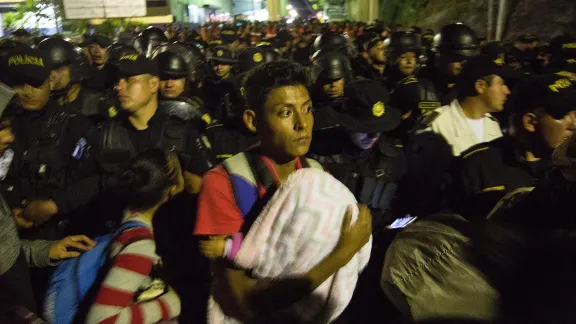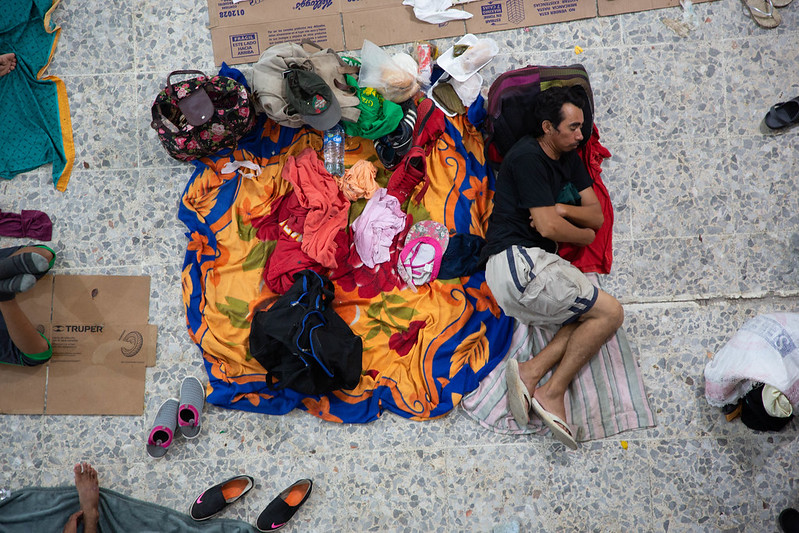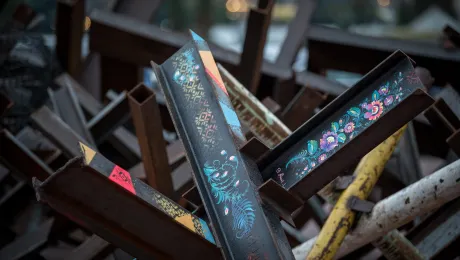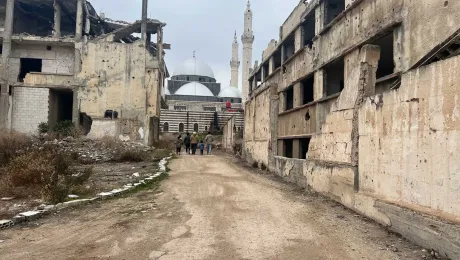
A father carries his baby at the Aguas Calientes border post between Honduras and Guatemala, close to a military roadblock. No undocumented migrant was allowed out of Honduras or into Guatemala, and anyone with an arrest warrant on either side of the border was taken into custody. Photo: LWF/Sean Hawkey
Skills training and human rights advocacy provide hope for young people facing poverty and violence
(LWI) - Following the caravans of people who left Honduras last year, with up to 15,000 asylum seekers travelling together to the US border, another two groups of forced migrants departed from Honduras in January and a third is planned for mid-February. Mexico has just received 9,000 applications for humanitarian visas from Honduras. At Tijuana on the Mexican/US border, an estimated 750 people pass through on a daily basis.
While this phenomenon has drawn much media attention, few commentators ask the key question of why these people are prepared to leave everything and risk the journey, often with young children, through territory controlled by cartels and criminal gangs, to a hostile and closed U.S. border?
Through its Central American program, the Lutheran World Federation (LWF) is tackling that question with migrants who have returned to Honduras, seeking to offer practical support and alternative solutions to the many problems they face.
Seeking asylum together
Migration to the US is nothing new and there are millions of Hondurans, Salvadorians, Guatemalans and Mexicans already living in the US, many of them with irregular status. But until now, these people seeking asylum and protection have travelled alone or in small groups, normally with smugglers as guides. This new way of travelling has several benefits for migrants. Firstly, they don’t have to pay the fees that smugglers charge, typically USD 5,000 per person from Honduras. Secondly, it is safer to travel in large groups than with smugglers, who work through criminal networks, often holding people for ransom, killing those who don’t pay up, and frequently kidnapping women and girls, selling them into slavery in the sex trade.
Mexico is often referred to as a “cemetery for migrants”. There are tens of thousands of stories of people being killed on the journey, and as many stories of rape, torture and disappearances. Supported by churches, there are frequent groups of mothers travelling through Mexico looking for their disappeared children.
Most of the forced migrants come from the so-called Northern Triangle of Honduras, El Salvador and Guatemala, and statistics show that around 80% of them are Hondurans.
For most of those people fleeing the country, violence is the main driver.
For most of those people fleeing the country, violence is the main driver. As the nation’s legal system has collapsed, criminals enjoy high levels of impunity, allowing gangs and trafficking groups free rein to ruin people's lives. Many of LWF’s beneficiaries left because of direct threats, because family members had been killed, or because they didn’t want their children to be recruited into criminal gangs.
Poverty is another driver, often related to food security and linked to climate change. Certain parts of the country are more heavily affected by prolonged droughts caused by climate change and some farmers haven’t had a harvest for 10 years.
Offering practical alternatives
Responding to the need for income and job opportunities, the LWF World Service program offers skills training for employment in carpentry, electricity and welding, as well as providing equipment and materials for the start-up of community and family micro-enterprises.
Supported by the LWF, young migrants in Olancho department have also set up a network providing training in human rights advocacy. Together with local government officials, two representatives of this network are now part of the first ‘Protection Table’ for returned migrants in Olancho, in the municipality of Catacamas. Among the tools they have developed to work on supporting returnees and discouraging new departures, is a book of young migrants’ stories, complete with photos and videos.
With around a million Hondurans in the US, there’s hardly a household in Honduras without a family member there. While many young people are still opting to follow in their footsteps and attempt the dangerous journey north, the LWF’s program offers some concrete alternatives and, above all, signs of hope for those choosing to remain.
By LWF correspondent Sean Hawkey and LWF Communications.
Churches publicly accompany forced migrants from Central America - 26 October 2018



